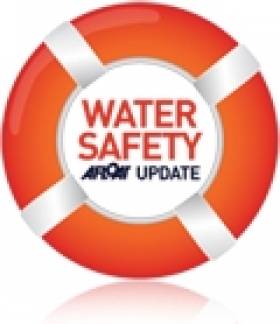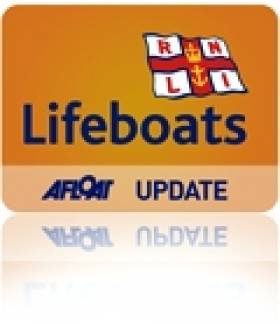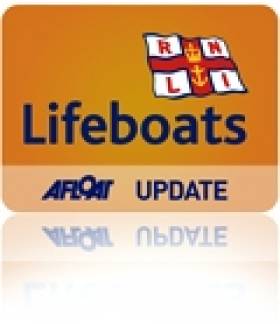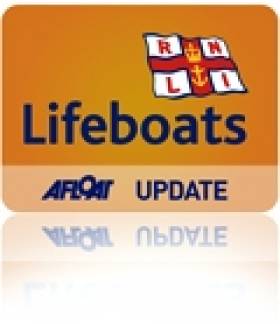Displaying items by tag: Rescue
Phaedo Team's Dramatic Rescue Photos of Rambler 100 Crew
Antoher competing yacht in the Fastnet race captured dramatic photos of the stricken 100-footer. Team Phaedos' media personnel who were at the Fastnet Rock last night waiting for photogrpahs of their big catamaran passing 'the Rock' when they got a call from the Irish Coastguard for all ships in the area to be on standby.
The media crew immediately abandoned the photography project and called in to the Coasguard to offer help. They found all crew on the up-turned hull of Rambler were fine and well, but 5 crew had drifted off from the upturned hull and were no longer in sight. They searched the area were they had received a personal EBIRB transmission from and miraculously found the missing 5 crew after they had been in the water for 3 hours.
"We pulled aboard our dive vessel owner George David and his four crew members who had all been strapped together, cold, but healthy, happy, safe, and well" said Team Phaedo's Rachel Jasperson. Dramatic Photos below.


r
Baltimore RNLI lifeboat crew were involved in the major rescue operation this evening (Monday 15 August 2011) when a 100 ft yacht capsized during the famous Fastnet race with a crew of 21 onboard. Five of the crew were missing when the lifeboat arrived on scene while the remaining sixteen were huddled together on the upturned hull.
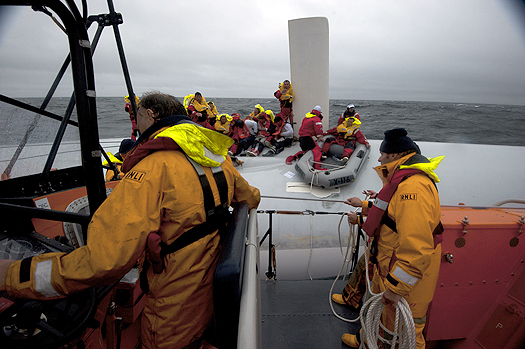
Baltimore lifeboat finds crew clinging to a daggerboard. Photo: RNLI
The Baltimore RNLI lifeboat was out on exercise near the Fastnet rock when they were alerted by Valentia Coast Guard that an emergency signal had been picked up. The lifeboat volunteer crew under Coxswain Keiron Cotter proceeded to the area and started a search. About sixteen miles southwest of Baltimore and five miles south of the Fastnet the lifeboat crew spotted the upturned yacht with the sixteen crewmembers on the hull. They told the lifeboat volunteers that five of their crew had drifted away from the yacht. After a short search the Coxswain returned to the scene and recovered the casualties onboard. They had been there for approximately three hours since their yacht capsized shortly after 5.30pm.
The other five crewmembers who were missing had managed to tether themselves together and were spotted in the water by the Baltimore deputy mechanic Jerry Smith who had taken out his own Dive boat to join in the search. One of the five was airlifted by the Irish Coast Guard helicopter to receive medical attention.

Rescued crew rejoice that all are safe, some spent three hours in the water. Photo: RNLI
The remaining twenty were brought ashore at Balimore Harbour and taken to the local sailing club to be assessed.
Baltimore RNLI Coxswain Keiron Cotter said, "We had no idea what we were looking for and it was extremely hard to spot the upturned yacht in the water. They had been there for about three hours with other vessels in the race passing nearby but not being able to see them. We were out on exercise in the area where they capsized and we must have just missed them by minutes.
We saw a light in the distance and did not know what it was so we went closer to investigate it. When we got nearer we saw that it was a torch the casualties were flashing to attract attention. Our priority was to get them back to shore as quickly as possible."
More photos and latest news in our Fastnet Coverage here
RORC's Racing Manager Ian Loffhagen said tonight a further statement will be released when more information becomes known.
Swimmer Dies After Being Swept Out to Sea
A 35-year-old woman died after being swept out to sea while swimming at a beach in Co Clare yesterday, the Irish Independent reports.
The Limerick woman, named locally last night as Julie Burke, was caught in a strong current at a beach across the bay from Lahinch around 3pm yesterday afternoon.
It is understood that a number of people on the beach attempted rescue, but the woman was washed away.
Shortly afterward she was located unconscious by crewmembers from the Irish naval offshore patrol vessel LE Aisling, who took her to waiting paramedics and a rescue helicopter waiting on shore.
The woman was airlifted to Galway's University Hospital, where she was pronounced dead at 5.45pm.
Divers Recovered from Lusitania Site After Boat Troubles
The Irish Times reports that the Courtmacsherry RNLI lifeboat went to the aid of divers at the wreck of the Lusitania yesterday.
The divers had been operating at the wreck site when their boat developed mechanical issues.
The lifeboat responded immediately in windy conditions and removed the crew to safety, towing the boat to Courtmacsherry.
As previously reported on Afloat.ie, divers led by the wreck's American owner hope to uncover the last big secrets of the stricken cruise liner, which was torpedoed by a German U-boat during the First World War.
A volunteer lifeboat crewmember from Newcastle in County Down and his brother rescued two children and four adults from the freezing water after their boat sank off the coast of Donegal yesterday (Tuesday 12 July). The two brothers, Richard and Samuel Burgess were out fishing on a six metre RIB Blue Haven at around 4.30pm when they heard a call from Malin Head Coast Guard on their VHF radio seeking urgent assistance for an 18 ft cruiser that was taking on water and sinking off Port na Blath in Sheephaven Bay, county Donegal.

Rescuers Richard and Samuel Burgess and their Red Bay Stormforce RIB
Realising they were near the area they immediately made contact with the Coast Guard and made their way to the scene. On arrival they saw debris and a small part of the bow of a vessel protruding from the water. Two children and four adults were nearby in the water and wearing lifejackets. The brothers immediately went to their aid and recovered all six onboard their RIB. The men also took their fleece and jacket off to wrap around the two children to keep warm. They then made their way back to land and the group were met by representatives from the Downings Coast Guard with the children taken on to hospital to be checked out.
Commenting on the rescue Newcastle RNLI lifeboat volunteer Richard Burgess said, "I can't believe that on my holidays with my brother Samuel in Donegal, we were involved in the rescue of six people from the sea. I didn't expect to be using my RNLI training away from Newcastle but I am delighted we were close by and were able to help these people. I have been on the lifeboat crew for twenty months and the minute we arrived on scene my lifeboat training kicked in.
Conditions on the day were good and the group were about half a mile out from the shore but the area is very rocky and they would have been unable to make it to shore on their own. It could have been a very different ending to the day and we are just delighted that everyone is safe."
The RNLI recommends that people always have a proper marine VHF radio onboard their vessel in case of emergency.
Four Teenagers Rescued in Dundrum Bay
Belfast Coastguard immediately tasked Southdown Coastguard Rescue Team and requested the launch of the Newcastle RNLI Inshore Lifeboat. Northern Ireland Ambulance Service also responded to the incident.
Whilst search and rescue units were proceeding to the incident, a gentleman who has formally served as a volunteer Coastguard and lives nearby assisted in the rescue. He managed to get his dinghy into the water and get to the teenagers who were showing signs of hypothermia and were complaining of the cold.
After recovering all four teenagers with his dinghy, he made shore to be met by members of Southdown Coastguard Rescue Team and NI Ambulance Service paramedics. The four were transported to hospital by two ambulances for further assessment.
Gary Young, Watch manager, Belfast Coastguard said:
These teenagers are extremely lucky to have been rescued this evening. I would like to pay tribute to the quick thinking of a former Coastguard who's actions certainly made for a happy ending to this potentially life threatening incident. Southdown CRT also showed their professionalism throughout this incident which was co-ordinated by MRCC Belfast.
We would like to remind anyone visiting the coast to take great care near water. Do not put yourselves at risk and if you find yourselves in trouble, dial 999 and ask for the Coastguard.
Belfast Coastguard received the initial call from a concerned member of public who had observed a young girl standing on an outcrop of rocks and in distress.
Immediately on receiving this call, Belfast Coastguard requested RNLI Bangor Lifeboat to launch and proceed with utmost haste to Cove Bay which is on the southern shores of Belfast Lough.
Within minutes of the rescue pagers being activated, volunteer RNLI lifeboat crew had assembled and launched the lifeboat.
Upon arrival at Cove Bay, lifeboat crew quickly evaluated the situation. With waves breaking around the knees of the frightened child it was paramount that she be brought ashore as quickly as possible.
The lifeboat was manoeuvred close to the rock ledge and the child was plucked to safety.
The young girl was brought ashore at Groomsport Harbour and was given into the care of waiting paramedics
Dr Iain Dobie a, RNLI volunteer crewman involved in this rescue said 'Large swells created by passing fast ferries and large boats could have swept this young girl from the rocks. When exploring rock pools and the foreshore please take a minute and think about rising tides and large swells'. He added 'We're very happy that the young girl is now safely ashore'
Lifeboat Rescues Stranded Sailor (and his dog) on Lough Derg
At 09.20hrs on Thursday morning, June 30, Lough Derg RNLI lifeboat, Toshiba Wave Warrior, went to the assistance of a person, who had been stranded since the previous afternoon, when his vessel had grounded on rocks at the mouth of the river Shannon in Terryglass Bay, at the most northerly part of the lake. The skipper of the vessel is a diabetic.
At 09.05hrs, Thursday June 30, Lough Derg RNLI Lifeboat was requested to launch by Valentia Coast Guard, to assist a person whose vessel was on rocks close the mouth of the river Shannon, in Terryglass Bay. The lifeboat with helm Eleanor Hooker, Peter Clarke and Robbie Garland on board, launched at 09.20hrs. Winds were south-westerly, Force 2-3, visibility was very good. The lifeboat was alongside the casualty vessel, a 23ft cruiser, at 09.45hrs. There was one person and his faithful dog on board.
The vessel had been grounded since the previous afternoon, and the skipper and his dog had remained stranded overnight. The skipper, a senior individual, told crew that he had got into the water and made two attempts to get the boat off the rocks himself, but without success. The alarm was raised by a local who heard his calls for help.
When the lifeboat arrived on scene, the person was quiet but alert and able to give a full history of events, he had kept warm overnight. He was assessed by Lifeboat crew and didn't give any medical history.
With a lifeboat volunteer on board, the vessel was taken off the rocks and to a landing point at Portumna Bridge closeby, 10.10hrs. Lifeboat Operations Manager Charles Stanley-Smith had called ahead and asked Deputy Launching Authority Fergal Kerney, who was in the area, to meet the lifeboat with food and a warm drink for the casualty.
Two friends of the person, who had been looking for him after it was noticed that his vessel was not at its mooring, also met the lifeboat at Portumna Bridge. They informed crew that the person suffered from diabetes.
The person, alert and able, was given food and drink and immediately taken for a medical assessment. A Garda from Portumna Garda Station was also on scene and Valentia Coast Guard had an ambulance on standby should it have been required. The lifeboat returned to station and was ready for service again at 11.15hrs
Two Successful Rescues by Bangor Lifeboat
On Wednesday 22nd June at 8.20pm Belfast Coastguard received information that an 18ft speedboat with 2 persons aboard had struck rocks close to Groomsport. Volunteer crew quickly assembled and launched RNLI Bangor Lifeboat which proceeded at full speed to the stricken vessel. Thankfully the two people onboard the stranded vessel were able to scramble safely ashore before the Lifeboat arrived on scene. Crew aboard the Lifeboat rigged a tow line and towed the speedboat to the safety of Groomsport Harbour.
On Saturday 25th June at 1.15pm volunteer RNLI crew were alerted by rescue pager that a 35ft yacht with 3 people onboard had lost all steering and required assistance. Belfast Coastguard gave the vessels location as 2½ nautical miles north east of Bangor Harbour. Bangor Lifeboat was launched and escorted the sailing vessel close to entrance of Bangor Harbour were a tow line was rigged. The yacht was then towed to the safety of Bangor Marina.
Kyle Marshall, senior RNLI volunteer helmsman at Bangor Lifeboat Station took this opportunity to stress five very important sea safety tips for anyone going afloat. He said. 'Always wear a lifejacket, secondly check your engine and fuel, thirdly tell others where you are going, fourthly carry some means of calling for help and final always check the weather and tides' He added 'We're happy that the crews aboard both vessels are now safely ashore'.





























